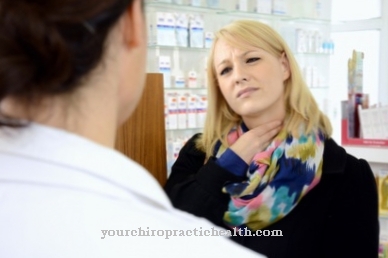Knee pain are among the common ailments in Germany and represent a clear warning signal from the body. It affects up to 10 percent of the population. Since the causes of knee pain can be very different, a medical examination is necessary. Knee pain can be cured quite well if treated in a timely manner. Knee pain should be differentiated from general joint pain.
What is knee pain?

Knee pain can also help avoid serious consequential damage to the knee through timely treatment. Meniscus damage caused by small tears or damage to the cartilage is usually painless and can cause major damage to the knee. They are often not noticed early due to the lack of pain.
In this respect, knee pain is a helpful warning signal from the body. Knee pain mostly points to three basic causes. On the one hand, there are traumatic injuries, such as those caused by accidents, and on the other hand, knee osteoarthritis can be the cause of knee pain. Obesity also often leads to severe knee pain.
In connection with knee pain, there may be cartilage damage and meniscus damage, cruciate ligament injuries and leg misalignments, bursitis. This can be clarified in the diagnosis by the specialist. Patients with knee pain should react immediately to the knee pain warning signal.
causes
The causes of knee pain can lie in very different processes. Cartilage damage or meniscus damage, injuries to the cruciate ligament, such as leg misalignments or bursitis can be the cause.
However, the explanation of the cause of knee pain always only includes the injury or osteoarthritis as a basic diagnosis. Diagnostic imaging methods such as ultrasound and digital X-ray diagnosis or CT, diagnosis using MRI or skeletal scintigraphy and 3D measurement of the spine are options for identifying the causes of knee pain.
Surface measurements of the muscles or bone density and laboratory diagnostics are also possible. When determining the cause of knee pain, the attending physician will decide the examination method.
You can find your medication here
➔ Medicines for joint painDiseases with this symptom
- arthrosis
- Patellar tendon rupture
- Patellar luxation
- Sports injuries
- Meniscal injuries
- Posterior cruciate ligament tear
- Muscle strain
- Meniscus tear
- Anterior cruciate ligament tear
course
Knee pain initially develops rapidly. Anyone who has knee pain cannot avoid taking it seriously, as everyday mobility is considerably restricted. If knee pain is not treated, this quickly leads to evasive movements and incorrect loading that will not improve the knee pain problem.
However, this increased strain on the knee can affect many other functions. In the long run, all tendons and ligaments can be damaged, inflammation can develop and the loss of mobility can increase.
In the end, only a surgical procedure can help. The course of the disease can only be positively influenced with timely medical treatment and diagnosis. If treatment starts quickly, there need be no dramatic course of the disease.
Complications
Knee pain has different causes, which have different complications. One cause could be overstressing the knee, which is often the result of intense sport such as running. Complications do not arise if the knee is spared and treated accordingly. However, if the pain is ignored, osteoarthritis of the knee can develop.
Osteoarthritis is a long-lasting process, with progressive wear and tear of the articular cartilage, which cannot regenerate. The abrasion of cartilage cells also causes an inflammatory reaction, which leads to swelling of the knee joint and additional pain. Often the wear and tear on the cartilage is so severe that the underlying bone is dragged along with it.
This leads to a thickening of the bone (subchondral sclerosis) and thus to a misalignment of the knee joint. The affected person can have problems with movement and in later years is dependent on a walking aid. A meniscus lesion can also cause knee pain. Complications mainly occur due to a surgical procedure, but these mainly affect surrounding tissue and infections are rather rare.
It is the same with a cruciate ligament tear. Postoperative bleeding and infections can occur here even after an operation. Elevated uric acid levels can also cause gout in the knee. If left untreated, infections and joint and bone damage can also occur here.
When should you go to the doctor?
Knee pain does not always require medical clarification. In the case of complaints that occur after one-time stressful movements, a professional examination is usually not required. Often it is just an overload of the knee. A visit to the doctor is recommended for particularly severe complaints that occur spontaneously or do not go away on their own after a few days. Medical advice is also recommended in the event of intermittent pain or if there is accompanying swelling or dysfunction. The same applies if the affected joint is reddened or the knee is unusually hot.
If the knee pain increases rapidly, there may be an initial underlying disease that must first be diagnosed. Knee pain after an accident or a sports injury should be clarified immediately by a doctor. The earlier the treatment, the better the healing process.
A visit to the hospital is recommended if a serious meniscus injury or ligament strain is suspected. Severe knee pain associated with bleeding should also be treated on an outpatient basis. If a severe ligament or joint injury is suspected, medical treatment should be given as soon as possible. The suitable contact persons are the family doctor, orthopedic surgeon and rheumatologist.
Doctors & therapists in your area
Treatment & Therapy
Knee pain doesn't always have to go under the knife. There are a number of conservative therapy options for knee pain, and acupuncture can also help. Cell biological regulation therapy and shock wave therapy or the TENS method can be used to treat knee pain.
Medical training therapy and matrix regulation training can also help with knee pain. Knee pain can be treated with many other methods with and without surgery.
Physical therapy methods and medical injection methods, but also chiropractic applications, deep heat and infrared applications, cold and heat therapy, ultrasound or oxygen therapy and occupational or electrotherapy and massages as well as various physiotherapeutic and physiotherapeutic therapy applications are therapeutic agents for knee pain. From sports medicine, the kinesio tape application is also a therapy for knee pain.
Outlook & forecast
Acute and chronic knee pain can be symptoms of osteoarthritis. It often occurs in old age. The affected patient suffers from wear and tear of the knee joint, which makes walking difficult. Injecting hyaluronic acid into the knee may provide relief for some time. The pain in the knee will be less, but care must be taken that these injections are given regularly.
However, this is not a permanent solution to knee pain. The administration of hyaluronic acid helps the patient to be able to move as easily as possible for a certain period of time. Even so, long hikes are not recommended for these patients. However, regular gentle exercise is important, such as swimming. When swimming, the knee joint is not as stressed as most of the body weight is carried by the water.
If knee pain is not treated, the pain and condition of the knee will deteriorate continuously. The patient is increasingly restricted when walking. In most cases, the knee joint is therefore surgically replaced by an artificial joint. This is followed by physiotherapy so that the patient can get used to the new knee joint. Regular exercise such as walking is important after such an operation, but no sports such as jogging should be practiced.
You can find your medication here
➔ Medicines for joint painprevention
As a preventive measure against knee pain, maintaining the ideal weight and getting enough exercise as well as a healthy and balanced diet help. If joints are affected, as is the case with knee pain, then there is usually a long lead in addition to acute traumatic injuries.
Anyone who permanently moves too little, just sits and eats poorly, will gradually notice the weakening muscle corset in the form that the joints are affected. The body joints, including the knee, are intended for movement. Those who permanently burden them with an unhealthy lifestyle will notice knee pain as a possible symptom. In this respect, the best prevention against knee pain is an active and healthy lifestyle.
Aftercare
Knee pain often requires consistent follow-up care. This is related, among other things, to the cause of the knee pain and is ideally discussed in advance with the family doctor, orthopedic surgeon or physiotherapist. Often, two things are involved in this context: On the one hand, the knee must be optimally protected after a treatment in order to make the regeneration as possible.
On the other hand, it is a matter of stabilizing the knee by strengthening the muscles surrounding the joint and in this way making it fully functional again. Rehabilitation sports teachers and fitness trainers with appropriate training are also the right people to contact for this type of aftercare.
The knee joint is often protected after an injury or even an operation with the help of a bandage, which must be worn as part of the aftercare according to the instructions of the treating doctors and therapists. When it comes to straining the knee, twist and shear forces in particular should be avoided as much as possible.
There are four parts to consider when strengthening. In addition to the muscles of the front and back of the thighs, the lateral cords must not be neglected. The better the adductors and abductors are strengthened, the less the joint can move to the side and the inner or outer ligament can be overloaded. Stretching exercises should also not be neglected in the follow-up care for knee pain.
You can do that yourself
If knee pain occurs during exercise or after an accident, training should be stopped immediately and the knee should be cooled. In the event of swelling, it helps first to put the knee up and to take it easy. Severe pain can be treated with an analgesic ointment. Support bandages and insoles help with walking difficulties. Those affected can orientate themselves on the PECH rule: break, ice, compression, elevation.
Inflammation and irritation can be reduced with the help of enzyme tablets or home remedies (pineapple, apple cider vinegar, quark, etc.). Pain is best relieved with the help of natural pain relievers such as chili. Later on, the symptoms can be further reduced through regular physiotherapy. After a few days of rest, the knee pain should go away on its own, but conservative treatment is not always enough.
If the symptoms persist or if complications such as severe swelling or muscle disorders arise, a doctor must be consulted. This is especially true if the symptoms keep recurring. To avoid knee pain, stretching and stabilization exercises can be included in the training plan. Overweight people should reduce their weight during treatment to relieve the knee.













.jpg)

.jpg)
.jpg)











.jpg)